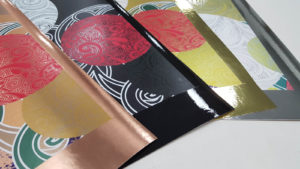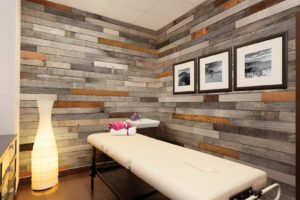
Combine textured fabrics, dazzling metallic effects, LED lighting and acoustics for interiors that impress.
In and of themselves, digitally printed wall and window coverings, as well as upholstery-type products for interior décor, add pizzazz to residential and commercial settings. Additional effects can boost the impact significantly.
The first product from DreamScape™, a division of Roysons Corp. in Rockaway, N.J., featured fabric embossing. Today the options have grown to more than 15 textures that reproduce canvas, leather, cobweb, rough plaster, sandpaper, silk and other uneven surfaces.
“In my opinion, flat is dead,” says Roy Ritchie Jr., Roysons’ president of wallcovering. “We understood that designers wanted more from digital printing. When we started, people were only printing smooth banners and plain vinyls. We got a lot of attention because we introduced a range of textures. The added dimension can really make a huge impact on a project, offering not only a more realistic appearance, but also a tactile experience.”
DreamScape’s Bling combines beads (raised dots) with the dazzle of gold, silver, bronze or copper.
“Metallic highlights have always been a big part of commercial wallcoverings; yet in the digital world, the ability to print with metallic inks is extremely limited,” Ritchie notes. “So DreamScape created a range of metallic-based products and special coatings that make a typical CMYK inkset look metallic.”

Most of the metallic effects at OAI Corp. of Tampa, Fla., are being used with its cut-vinyl products.
“We also incorporate LED into frames that then illuminate and enhance the fabric,” says Marissa Howe, marketing coordinator. “Retail, hospitality and corporate offices typically order these types of items.”
Rainier Industries of Tukwila, Wash., has also been working with backlit fabrics in LED-incorporated frames. Sales manager Charlie Rueb notes that digitally printed products are not limited to providing visual effects.
“Acoustical solutions seem to be a growing segment in décor,” he says. “We have options for acoustical tiles, as well as acoustical walls.”
The construction of DreamScape’s materials offers a base level of sound absorption, Ritchie says. “But if a customer is asking for help with acoustics, we recommend they add a sound-absorbing layer underneath the wallcovering.”
4walls of Cleveland, Ohio, prints digitally on fabric that gets wrapped around fiberglass acoustic panels. “You would see those in offices in gray fabric that people use as pin boards,” creative director Greg Koeberer says. “Now you can have a design or image.”
Janice Kleinschmidt is a magazine editor and freelance writer based in San Diego, Calif.
 TEXTILES.ORG
TEXTILES.ORG


